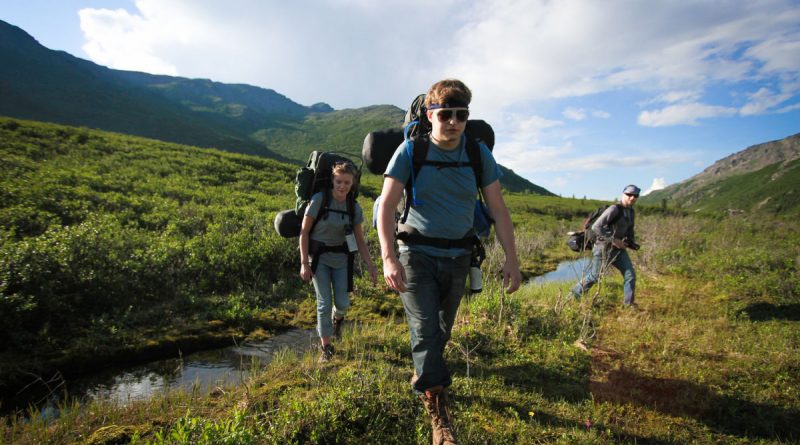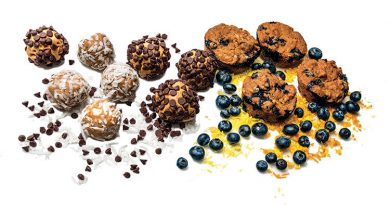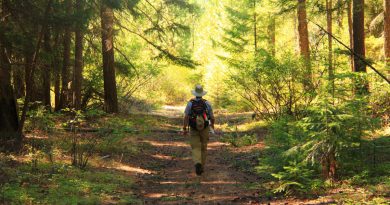The Hike Forever Fitness Plan: Age 18-35
Build your fitness foundation with this essential physiological info, tips on eating right and exercises for staying in prime hiking shape.
Your Body
At this age, you’re at your physical peak: fast, strong, and quick to recover. That lets you play hard–but without training, you won’t reach your potential or lay a solid foundation for later years. Robert Mazzeo, professor in the Department of Integrative Physiology at the University of Colorado-Boulder, says you only get one shot at making the most of this stage’s “optimal physiological and biochemical adaptations.” Start with our age-adapted workout at the bottom of this post, then get hiking.

A: Circulatory system Pliable capillaries and cell walls easily transfer nutrients and oxygen from the bloodstream to the muscles and clear away muscle-fatiguing waste. This enables shorter recovery time and powers endurance training. Optimize it: Endurance training (45-60 minutes of cardiovascular exercise at a perceived exertion (PE) of at least 13) increases capillary supply to muscles and enhances overall performance.
B: Heart A 20-year-old’s ticker is capable of pumping 10 times the amount of blood needed to preserve life, which means there’s plenty of power to supply muscles with oxygen–even during the toughest climbs. Optimize it: Sustained exercise (long dayhikes) will lower your resting heart rate, the hallmark of well-trained athletes.
C: Lungs The body creates new alveoli (the tissue that moves oxygen through the lungs) until you’re 20, fueling peak respiratory function and flooding your muscles with oxygen during exercise–even at altitude.
D: Energy Muscles and the liver store maximum concentrations of glycogen, a form of sugar that quickly converts into energy during high-intensity exercise and helps you go longer without bonking. Optimize it: To refill energy stores after a long hike, sip 8-10 ounces of fortified hot cocoa (add 1 heaping tablespoon of dried milk to mix), and have a solid meal within 45-60 minutes.
E: Bones Mineral density peaks when you’re 30, making your bones as strong as they will ever be. Optimize it: Carry someone else’s load. Bones achieve peak mass through loading and high- intensity workouts (see Muscles)
F: VO2 Max This measurement of maximum oxygen consumption is a major indicator of athletic potential–and it peaks at 25. When your muscles strip oxygen efficiently, it means more energy and less fatigue. Optimize it: Do intervals. They’ll continue to increase your anaerobic threshold (the hardest exercise you can sustain) and increase your VO2 max.
G: Joints/cartilage/back Total body water per pound of body weight is at its highest between the ages of 18 and 25. All of that fluid helps keep cells elastic, joints springy, and the lumbar discs between vertebrae spongy and shock-absorbing. Optimize it: Cross-train with biking, skiing, and swimming to preserve cartilage health.
H: Muscles Studies show that quadriceps reach their maximum isometric and dynamic strengths when you’re 30. The maximal strength of other muscles peaks between 25 and 35. Optimize it: Build muscle with high-weight, low-rep strength training. Do squats, bench presses, and dead lifts with 80 percent of your repetition maximum (the most weight you can lift once). Do 6 reps, 3-6 sets per exercise.
Eat Right and Stay in Shape
At 25, you can bust out a dozen miles on two Twinkies. But the savvy hiker is eating for the future. Focus on prevention–by downing foods that help prevent cancer, diabetes, heart disease, hypertension, arthritis, and osteoporosis.
Call it the paleo-Mediterranean diet: Build your menu around fresh whole vegetables, free-range meats, cold-water fish (like salmon), nuts, and fruits. These foods are low in heart-clogging saturated fats and refined carbohydrates and sugars, and high in omega-3 fatty acids, which promote cell membrane health. Nuts are loaded with B vitamins, especially B12, which improve your mood and fight stress. Reasonable portions of red meat (grass-fed, not corn-fed) also help regulate hormones and support your reproductive system.
Power Bites
Set the stage for a lifetime of healthy summits by preventing disease onset with this delicious, stress-lowering, vitamin B-packed gorp.
1 cup dried unsweetened blueberries
1 cup raw peanuts*
2 cups maple pecans
1/2 cup chia seeds (available in most health-food stores)
1/2 cup sunflower seeds
1 cup unsulphured apricots, quartered
1 cup unsweetened cranberries
*If allergic to peanuts, substitute cashews
Stay Loose to Prevent Injury
In a 2008 study at the University of Las Vegas, Nevada, researchers found that static stretching (the kind you hold) made athletes less powerful. Dynamic stretching, on the other hand, loosens muscles and increases range of motion. “I do complete movements that engage and lengthen every muscle,” says distance hiker Andrew Skurka. Move in and out of stretches for 30 seconds, repeating each 3-5 times.

1. Hamstrings
With legs extended straight in front of you, reach for your toes. Ease off, reach again.
2. Groin, hips
Sit in the butterfly position and gently move your knees up and down in one fluid motion.
3. Hips, quads, glutes
Lie on your back with your right ankle crossed above your left knee, and both hands placed behind you. Lift your trunk off the ground, and gently push your upper body toward your feet. Release and repeat, alternating sides.

Trail mix recipes by Esther Cohen (sevenbowls.com)
Yoga poses by Margaret Burns Vap (bigskyyogaretreats.com)
Common Ailment: Traumatic Injuries
Youthful recklessness can lead to rolled ankles and wrecked knees.
Prevent Avoid taking unnecessary risks when boulder-hopping across streams or traversing loose scree slopes. Slow down on steep descents.
Soothe RICE: Ice with cold water or snow, elevate the joint as much as possible, and compress in an ACE bandage or T-shirt. But don’t wait too long to get moving again. “Inflammation peaks at around 48 hours,” says John D. Kelly IV, M.D., spokesman for the American Academy of Orthopedic Surgeons, “so the joint could become too swollen to ambulate.” When it’s time to hike, keep the wrap on. It’ll add support, control swelling, and reduce pain.
Strengthen Increase ankle stability by placing the outside of your foot against an immovable object and pushing outward for 15 seconds. Repeat five times; do the exercise with your inner foot. Fortify knees with quad-building single- straight-leg raises. (Lie back, raise your straightened leg, and hold for five seconds. Lower slowly and repeat 10 times.)
The article was originally seen at https://www.backpacker.com/skills/fitness-special-mdash-hike-forever-age-18-35
Originally posted 2018-04-05 17:18:50.




